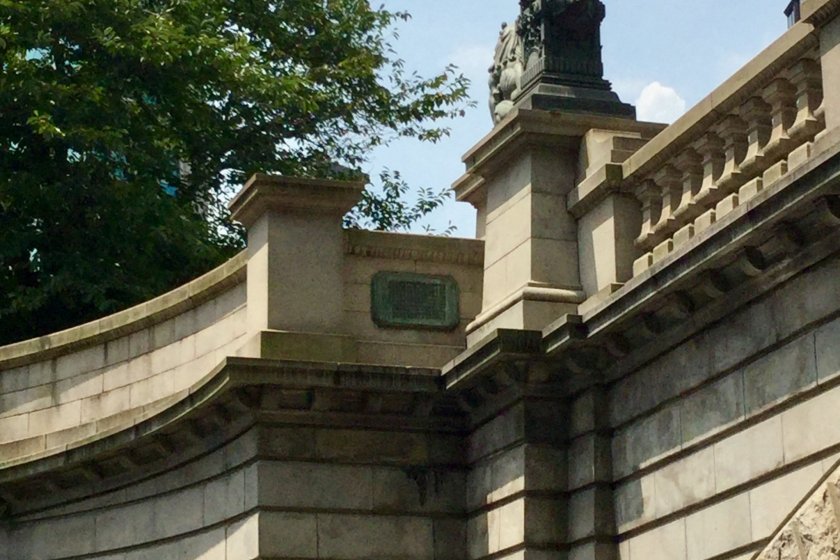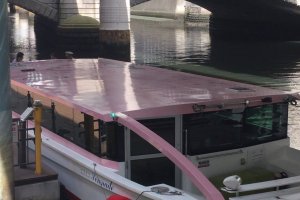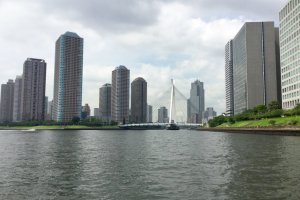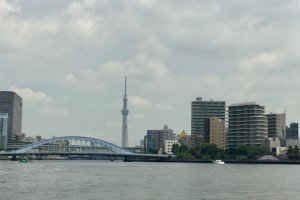Tokyo summers can be brutally hot, and sophistication is hardly a word that comes to mind as you stand drenched in your own sweat even when you're barely moving. But there are pleasures to be had in every season, if you know where to look for them. At Nihonbashi, it is possible to enjoy the best of summer, harnessing wisdom handed down from the Edo Period on ways to stay refreshed. Here was how I spent a summer day in style at Nihonbashi.
River Cruising
Since the Edo Period, Tokyoites found relief from the summer heat by going near the water. The easiest way to do this without actually getting wet is by riding pleasure boats. Stay fashionably dry as your boat sails through the river bringing much sought-after breeze, which is naturally cooler near the water. In celebration of the 100th anniversary of Nihonbashi (2011), the boarding dock was completed and is located at the foot of the bridge. I joined the 60 minute course with the Tokyo Bay Cruising company on board the SS Serenade, which took us out all the way to Odaiba and the Rainbow Bridge. The tour guide directed our attention to points of interest in English.

Having lived in Japan for almost 10 years now, it still amazes me how much I still do not know about Tokyo. There is a perspective of the city that is only possible from the water.

It was fascinating for me to survey how much reclaimed land was developed by the Tokugawa administration to push the waterfront further and further into the bay into what we know today. If you love taking photos, you will have an amazing time taking unobstructed views of the Skytree, the Tokyo Tower, the Rainbow Bridge, Kachidoki Bridge (a bridge that used to open up to let ships through -- river cruises can take you right under the place where it used to open).

There is a specific point during the cruise for about a few seconds when you can see both the Tokyo Tower and the Skytree at the same time and if you have a camera that can take panoramic shots, you will be rewarded with a photo most people cannot take on land. The cruise took us past the Olympic Village which is still under construction. Tokyo is constantly changing, not only with the seasons but also with new constructions. When you join a river cruise periodically, you will be able to study the gradual transformation of the waterfront and collect your own set of time-lapse photos.

Sailing back to Nihonbashi, we were treated to a rare view of the iconic bridge. I'm sure I'm not the first to say it and I won't be the last but I do wish that someday, Tokyo will transfer the highways underground to restore the former glory of the bridge backdropped only by clear blue skies.

Strolling Through the Wind Chime Forest
The yukata became a favorite summer garment of common folk during the Edo period, thanks to is light fabric and breezy features. But like its heavier and more formal cousin, the kimono, everyone -- men, women, and children -- can wear them and go to their summer events in the classiest apparel possible, given the heat. Nihonbashi is reviving this tradition by encouraging visitors to don their yukatas. From July 6 to September 24, 2018, participating establishments in the Nihonbashi area will be giving novelty items and special services to visitors wearing a yukata. I didn't wear one this time but our guide looked ultra chic in hers!

In the 19th century, someone came up with the idea of glass wind chimes. Japanese people found the sound psychologically invigorating in the insufferable summer, and since then, glass wind chimes have been associated with summer. This year, the pathway between Fukutoku Shrine and the garden is lined with 190 Edo-style wind chimes in various colors and designs. You will feel the double cooling power of the chimes surrounded by vibrant green foliage.

If you wish to linger, tables are covered with a green roof and mist cools off the immediate area.

Edo-Style Sushi and Stimulating Kyōgen
When it's unberably hot and humid, the last thing you want to eat is a hot heavy meal. For lunch, we went to Suigian, Nihonbashi's trendiest theater themed restaurant and lounge located right under the Fukutoku Shrine. Suigian is the only place you can eat authentic Edo-Style sushi, a method of making sushi that takes so long that practically all sushi restaurants have abandoned it in favor of faster methods.
Before lunch, we were treated to Kyōgen, a form of comic theater. The actors spoke an old form of Japanese but one does not need to understand the dialogue to appreciate Kyōgen. Good humor after all is universally refreshing.

Suigian's sushi set is, unquestionably, the best sushi I have ever had -- the freshest seafood on rice that is perfectly balanced in flavor and texture -- truly a treat worth slowing down and savoring.

Dessert was deceptively simple but no less a delight to the taste buds: traditional sweets paired with green tea both from long established confectionary and tea stores in Kyoto.

See why Nihonbashi is quickly becoming a favorite summer spot within Tokyo.



































For now, I’ve got to see the Art Aquarium.